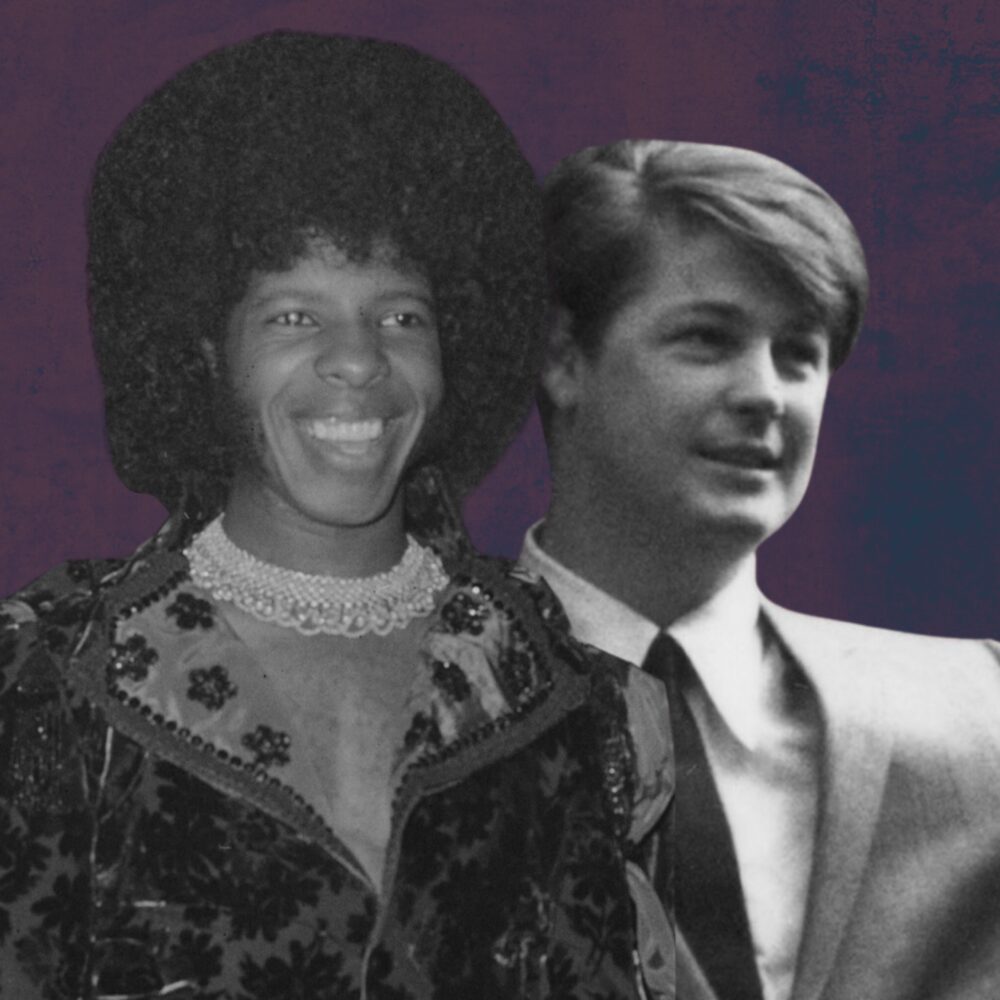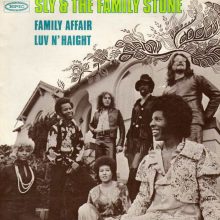Sly Stone And Brian Wilson, Pop Visionaries Who Retreated From A Cruel World

Central Press/Hulton Archive/Getty Images, Ethan Miller/Getty Images
Here’s a thought exercise: Try to imagine what your record collection would look like if Sly Stone had never lived.
Forget Stevie Wonder’s mid-’70s dalliances with bottom-heavy funk. Get rid of Miles Davis’ avant-funk freak-out On The Corner, which was heavily inspired by Davis’ obsessive listening to Stone’s downbeat masterpiece There’s A Riot Goin’ On, and lose Herbie Hancock’s own funk-fusion era, which includes “Sly,” a 10-minute scorcher named after you-know-who. Sampledelia classics like Paul’s Boutique and It Takes a Nation Of Millions To Hold Us Back would lose some of their freakiest grooves, which real heads know were transplanted from Sly deep cuts a generation earlier. (God bless the Dust Brothers for rescuing “Loose Booty” from obscurity.) And who knows whether Soulquarian-era classics like D’Angelo’s Voodoo would exist in their current form.
It is frankly impossible to imagine the last 55 years of popular music without Sly And The Family Stone’s hazy alien-funk grooves, radical production techniques, racially integrated band, and remarkable songcraft, both the optimistic pre-1970 we-gotta-live-together anthems and the strung-out post-1970 narcotic grooves.
OK, now try the same exercise, but with Brian Wilson.
Now watch as Sgt. Pepper’s Lonely Hearts Club Band (which Paul McCartney has admitted “nicked a few ideas” from Pet Sounds, the Beatles’ then-greatest influence), Odessey And Oracle, Bryter Layter, The Soft Bulletin, Black Foliage, every Weezer album except maybe that shitty covers record, Person Pitch, Fleet Foxes, and 400 other albums vanish from your collection like Marty McFly’s relatives. Without the whacked-out, psych-pop fragments of Smiley Smile, Elephant 6 would get downgraded to Elephant 2. Animal Collective’s whole thing is just “What if the Beach Boys joined an inner-forest cult, screamed a lot, and then discovered samplers?”
That whole clichéd archetype, memorably parodied in Walk Hard, of a musical genius cooped up in a recording studio for months with a string section and bicycle bells and theremins and an obsessive vision that can’t be comprehended by mortals? Yeah, Brian Wilson started that. He was just a guy who believed that pop music could bring you closer to God, that a pop song could be labored over as artfully and meticulously as Beethoven labored over his Fifth Symphony, and who arguably lost his mind in pursuit of these ideals. He also, crucially, wrote some of the most astoundingly beautiful melodies of the 20th century — songs like “God Only Knows” and “Wouldn’t It Be Nice” and “Good Vibrations” and “Surf’s Up,” songs that people play for their newborns to introduce them to the concept of music.
Sly Stone and Brian Wilson were two genuine visionaries who gave us so much, suffered so much, and both retreated from the outside world for long stretches of time, burrowing inside themselves, as their music became raw material for entire genres and subgenres and sub-sub-genres. And they both died this week — strangely, both at age 82. It’s not an exaggeration to say the entire music community is in mourning. It feels a little like that grim stretch of 2016, when a different icon seemed to be dying each week.
Pet Sounds was the album that best heralded the mid-’60s pivot point between rock ‘n’ roll as a vehicle for radio singles and the more sophisticated, “album-centered” approach embraced by groups like the Beatles and the Who during the decade’s latter half, a shift coinciding with Wilson’s own evolution from writing songs about girls and surfing to writing songs about crushing loneliness and alienation. It’s often cited as rock’s first concept album, though, as Wilson himself put it, “It wasn’t really a song concept album, or lyrically a concept album; it was really a production concept album.” I’ve also seen it described as a precursor to emo, and while that’s a bit much, the wounded vulnerability Wilson explored in songs like “I Just Wasn’t Made For These Times” was, true to that title, decades ahead of its time.
Similarly, Sly And The Family Stone’s There’s A Riot Goin’ On heralded a turning point not just in its creator’s discography but in the larger culture, too. With its brooding, paranoid tunes, it’s reflective of the death of the ’60s dream, the sound of civil rights-era optimism curdling into despair, disillusionment, and drug addiction. With their murky, sluggish grooves and pioneering use of drum-machine rhythms, Riot and its follow-ups, 1973’s indelible Fresh and 1974’s deeply underrated Small Talk, departed from the radio-friendly soul of the ’60s and inaugurated the sweatier, more sophisticated funk of the ’70s. Brian Eno famously described Fresh as a watershed album in recording history “where the rhythm instruments, particularly the bass drum and bass, suddenly become the important instruments in the mix.”
I don’t mean to belabor the point: Brian Wilson and Sly Stone were two vastly different artists with vastly different bodies of work. They were not the same. But they were both shy, wounded souls, both icons who emerged from mid-century California, both haunted by a kind of darkness their listeners did not always understand, and I can’t stop thinking about how they both embodied the burdens of pop success relatively early on and wound up withdrawing from the world. As Flea observed in a video eulogy on Thursday, “The cruelty of the world was a lot for them to bear, I think for both of them.”
Towards the end of Questlove’s excellent new documentary Sly Lives! (aka The Burden of Black Genius), André 3000, one of several Sly-inspired icons interviewed in the film, reflects on Stone’s eventual slide into drug addiction. “If you’ve been on this heightened, explosive life, your body has taken in so much energy,” the rapper-turned-flautist muses. “You’ve given out so much energy. And you stop. Where does that energy go? What are you feeding from? What’s taking up that space now?”
In Stone’s case, the answer was clearly drugs, which consumed the icon’s life and finances as his career took a downward turn in the mid-1970s and onward. Throughout the ’80s, during which the Family Stone’s career ended with the failed comeback attempt Ain’t But The One Way (1982), Stone was in and out of jail and rehab, and he gradually receded from public life, sequestering himself in a mansion compound in LA. In Questlove’s doc, George Clinton sums up these years thusly: “Me and Sly, we were crackheads!” It’s a funny segment that becomes less funny when Stone’s daughter, Phunne Stone, appears onscreen, recalling how, as children, she and her friends would snort chalk because they wanted to imitate what they saw “grown folks” doing.
Thankfully, Stone survived his addiction years, avoiding the early demise that befell so many of his contemporaries, and lived long enough to bask in some overdue recent recognition, with the release of Questlove’s documentary and Stone’s own 2023 memoir, Thank You (Falettinme Be Mice Elf Agin). Still, he never staged a successful comeback and also never got to enjoy an easy retirement. In 2010, then living in a white camper van (which he later said was by choice), Stone sued his former managers for allegedly defrauding him out of millions in royalties. He long remained a recluse, a puzzling enigma even to his fans.
Like Stone, Wilson sank into drugs, alcoholism, and self-destruction during the 1970s, his career and marriage deteriorating. At a low point in 1978, he hitchhiked from Mexico to San Diego and wound up hospitalized after being found by police in a park without shoes or money.
Unlike Stone, Wilson’s troubles were accompanied by much-mythologized struggles with mental illness that seemed inextricable from the heightened sensitivity he brought to his songwriting. You’ve heard the famous stories, immortalized in rock lore: His 1964 nervous breakdown and withdrawal from touring. How he isolated himself in his bedroom for much of 1968, self-medicating with amphetamines and cocaine, tormented by his failure to complete the Beach Boys’ long-gestating magnum opus SMiLE, which he’d conceived as a “teenage symphony to God.” How he became haunted by paranoid delusions, believing that the recording of his song “Fire” was somehow responsible for a building burning down. How he was so spooked by John Frankenheimer’s 1966 film Seconds that he subsequently avoided movie theaters for 16 years. How he installed a giant sandbox in the dining room of his Hollywood Hills home so he could feel like a kid again.
Eventually, Wilson fell under the sway of a bizarre psychotherapist, Dr. Eugene Landy, who subjected him to a 24-hour therapy regimen. Landy, whose overbearing involvement with Wilson was memorably dramatized in the 2015 biopic Love & Mercy, eventually assumed total control over the musician’s personal and business affairs before losing his psychology license and being court-ordered to avoid contact with Wilson.
For years, Brian Wilson seemed like a walking cautionary tale: a tortured soul unable to cope with the pressures of pop stardom. As he told Rolling Stone in the late ’80s, “Being called a musical genius was a cross to bear.”
So it’s remarkable that he managed to stage a career comeback with his eponymous 1988 solo album; that he spent much of his final decades touring as a solo artist and enjoying what seemed like a stable family life with his second wife and giving bewildering interviews; that he even managed to revisit and remagine SMiLE in the form of a gloriously orchestrated 2004 solo album. It feels like a miracle that a version of SMiLE was completed during Wilson’s lifetime, with his leadership, instead of winding up as a posthumous cash-in. And it felt like a minor miracle when I got to see Wilson perform Pet Sounds in its entirety around the 50th anniversary in 2016. Last year, Wilson was reported to be suffering from dementia, and it was clear that his fruitful second (third? fourth? fifth?) act was nearing its end.
We should be grateful, I suppose, that both Sly Stone and Brian Wilson lived to their 80s and got to see their influence breathe new worlds into being. They are — were — by any measure, among the most significant visionaries of 20th-century popular music. May they both rest in the kind of peace that seemed to elude them for much of their lives on earth.








